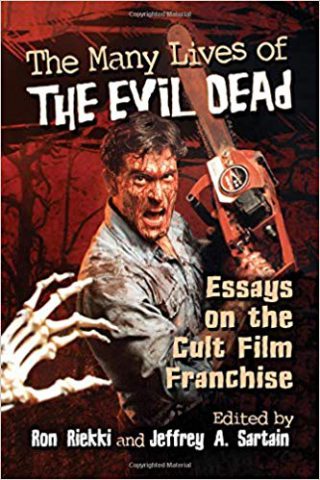Michigan director Sam Raimi in 1981 with a tiny budget and main actor Bruce Campbell shot the story of a powerful ancient book and the consequences of citing from it aloud in the Tennessee woods. The horror movie The Evil Dead was first presented at the Cannes festival in 1982 (where Stephen King praised its originality). It would become one of the top-grossing independent movies of all time.
 International distribution for the film met with many difficulties due to the extreme violence of the plot; some countries had it indexed for decades and forbid public screening or video distribution, while in some countries edited versions were available. Some audiences and self-elected moral guardians failed to see that in the film a lot of humor, cynicism, intertextuality, parody and slapstick were at work, too. What is called “splatstick” now. Those critical voices were not aware of the latest style of the American horror movie, the slasher, that dominated the genre until the mid 1980s.
International distribution for the film met with many difficulties due to the extreme violence of the plot; some countries had it indexed for decades and forbid public screening or video distribution, while in some countries edited versions were available. Some audiences and self-elected moral guardians failed to see that in the film a lot of humor, cynicism, intertextuality, parody and slapstick were at work, too. What is called “splatstick” now. Those critical voices were not aware of the latest style of the American horror movie, the slasher, that dominated the genre until the mid 1980s.
The origin Evil Dead movie saw three follow-ups altogether. In 1987, Raimi shot Evil Dead 2 – Dead by Dawn, in part a recap of the previous film but also a sequel, though with a more comedic air about it.
In 1993 (US release) Army of Darkness also by director Raimi let protagonist Ash travel back in time and experience all kinds of weird slapstick and more gore and splatter action in the middle ages.
Then in 2013, an entirely new and fresh version of the first movie was directed by Fede Álvarez, this time by the title of Evil Dead, featuring a female main character and sole survivor. From 2015 to 2018, the original trilogy was continued on US TV as the series Ash vs. Evil Dead, with leading actors Bruce Campbell, Ray Santiago, together with guest stars Lucy Lawless and Lee Majors. Besides the purely cinematic and theatrical versions of the franchise, The Evil Dead story was continued in comic books, video games, and a musical. (Several other horror movies refer and allude to it or had the film featured in a sequence when characters watch it on Halloween.)
The three parts of the book by authors/editors Riekki and Sartain are organized in „The Films,“ “The Franchise and Adaptations,” and a section where three people involved in the production of any of the parts have the word. Bill Vincent (fake Shemp and one of Raimi’s professors), L. Michael Elliott, director of the Evil Dead musical, and most prominently Betsy Baker, the original character of Linda (Ash’s girlfriend) from the The Evil Dead recall filming, editing and acting for the franchise.
The various texts muse on “video nasties” in Britain in the 1980s (where the first movie became the top title in video sales), specifics and differences (in film research and popular culture) of zombies and Deadites, Raimi’s violation of the “Final Girl” rule in slasher movies, gender roles in horror cinema, and Hugo Münsterberg’s writings on film. Some of the 23 texts are very brief (5 or fewer pages) and focus on just one single aspect of the franchise.
A topic enlarged on by several authors, is the steady success of actor Bruce Campbell, who blends his own biography strongly with the movies and the franchise, thereby always making sure that he would not take any of it really seriously, which in turn gave him lots of sympathy from fans. Actually, he is the one “piece” of success that keeps all the parts of this unique horror epic together; a continuing story now covering 40 years (filming for The Evil Dead started in 1979). His fame as a B-movie actor led to several (recurring) roles and guest appearances in the TV series Xena, Brisco County jr., Hercules, Ellen, Burn Notice and several Blockbuster movies.
Other texts deal with historical suspicions about cinema itself and how the technology affects and almost hypnotizes man, the origins of evil, demons, vice and horror in literature, and the dangers of the “Evil Image.” Other writers go deeply into production specifics like the “shaky cam,” or the different gazes and modes of identification the viewer is more or less forced into.
Though not the first volume to deal with either Campbell or The Evil Dead universe, the content here is fresh and covers some new ground (Ash vs. Evil Dead only finished in 2018, a continuation of the series is uncertain). For horror (comedy) film buffs and dark fantasy fans, this volume will be of some interest.
Review by Dr. A. Ebert © 2019
Ron Riekki and Jeffrey A. Sartain (eds.) The Many Lives of The Evil Dead: Essays on the Cult Film Franchise. McFarland, 2019, 219 p.
